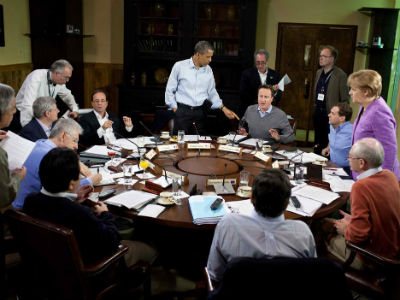Robert Kaplan, writing a commentary for Strategic Forecasting, argues for a harder more competitive approach to foreign aid. Certainly controversial, the full article can be obtained here. Extracts are below...
Geopolitics connotes hard power,
concerned as it is with the struggle over control of geographical
space, a struggle that is primarily military and economic.
Unsentimentality is the order of the day. Geopolitics and realism go
hand in hand, therefore. Humanitarian aid would seem to have no place in
this worldview. But that, as it turns out, is far too simplistic.
For
power is also the power to persuade, and persuasion can take the form of
winning friends, one village at a time. A policy that is purely
military and economic has no idealistic component, and in an age of
global media an idealistic component is required for credibility in the
public space. In fact, foreign aid, as it came to be known
during the Cold War, was a critical part of America's struggle against
world communism. Building schools and roads, and teaching children how
to read and farmers how to take advantage of the latest agricultural
methods, was not merely altruistic; for it had the ulterior motive of
demonstrating the superiority of America's values over those of its
adversaries. When in 1961 President John F. Kennedy launched the Peace
Corps, though his words were suffused with idealism, realpolitik was not
far from his thoughts.
But
the meaning of foreign aid has subtly shifted in the post-Cold War
years. According to a commonly received narrative prevalent in the
media, because communism has been vanquished, foreign policy is finally
able to pursue idealistic ends untainted by realpolitik. Henceforth,
foreign aid should be purely humanitarian, with minimal concern for
whether or not it benefits U.S. national interest.
Ironically, this very altruism that abjures national interest
has made America's foreign assistance programs not better but worse.
Foreign aid is like any other organized pursuit: It requires a
competitive mindset to excel. Aid workers must be aware of the
ideological, philosophical and political opposition they will likely
encounter in the field and prepare strategies to defeat it. They must
learn to compete, in other words...

... because the military thinks competitively and the foreign
assistance bureaucracy does not, the military is far more effective
than the State Department, with the result being the militarization of
foreign policy. Counter intuitively, the way to reduce America's reliance
on hard power is to get the foreign aid bureaucracy to adopt a harder,
more competitive approach to its own soft power. If the aid community
thought competitively, like the military and the intelligence
communities do, it would be more effective in the field, and the
militarization of foreign policy would consequently diminish. "The
imbalance between military and non-military instruments of power is
likely to continue unless civilian agencies develop approaches which
account for the contested landscapes in which they function," Schadlow
explains. She quotes an Australian government aid expert: "Aid is 10
percent technical and 90 percent political."
Aid,
in other words, is a form of political warfare, something that
America's Cold War presidents well understood. That doesn't mean, for
example, that you export democracy-building programs to every
non-democratic country as part of a moralistic foreign policy that pays
no heed to realpolitik. For there may be a few places where you will
want to cultivate authoritarian leaders, and such programs would then
undermine your strategic goals. Aid is not some politically neutral tool
that operates separately from foreign policy -- rather, aid, as well as
seeking to do good, must also advance a state's interests. And the more
tough and competitive the aid mindset, the more likely it is to
succeed.
We
must stop putting humanitarian aid on a pedestal. While the geopolitical
interests and moral values of a great power like the United States do
not always overlap, most of the time they do, and therefore there is
nothing debased or cynical about seeing civil and military power as two
inextricable aspects of the same foreign policy machine. Indeed,
efficient humanitarian aid requires language and other forms of cultural
area expertise, which is also of use to the military. The military,
meanwhile, uses operational and strategic planning processes to
determine who the opponents are likely to be once soldiers and Marines
hit the ground. The aid bureaucracy should do likewise. Each branch of
foreign policy can assist and leverage -- and learn from -- the other...
... Face it: the militarization of foreign policy was not only
the result of decisions taken by the younger Bush administration, or
even of a State Department starved of funds. It was also the result of
the thoroughly undynamic mindset of Foggy Bottom. Rather than have the
military become softer, the State Department has to become harder. That's the real road to soft power.
Obtain full article from Stratfor here.



























